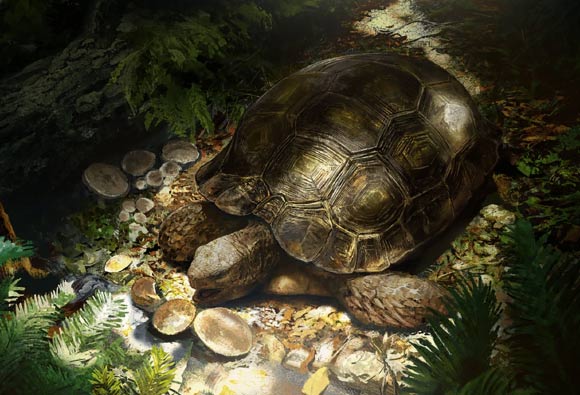Paleontologists from the Institute of Paleobiology at the Polish Academy of Sciences and the Universitat Autònoma de Barcelona have described a new species of the tortoise genus Manouria based on the fossilized remains found in the Czech Republic.
Manouria morla lived in the swamps of what is now the Czech Republic during the Early Miocene, between 20 and 17 million years ago.
The species is the oldest member of the Manouria lineage, which nowadays inhabits Southeast Asia only and includes four extinct and two living species: the Asian forest tortoise (Manouria emys) and the impressed tortoise (Manouria impressa).
“Tortoises (Testudinidae) are a clade of turtles highly specialized to terrestrial environments, mainly living in semi-arid conditions,” said Dr. Milan Chroust, a paleontologist with the Institute of Paleobiology at the Polish Academy of Sciences, and colleagues.
“Members of the clade Testudinidae larger than 35-75 cm (14-30 inches) in total carapace length are classified as medium to large tortoises, whereas species larger than 75 cm are considered to be giant-sized.”
“The living species of the Testudinidae are simply divided into three main different groups: the basal Gopherus and Manouria (recovered either as a basal genera or as consecutive branches), as well as the Geochelona clade and the Testudona clade, the latter two constituting the subfamily Testudininae.”
The fossilized remains of Manouria morla — parts of the carapace and plastron as well as numerous indetermined shell fragments — were found at the Ahníkov I fossil site in the Most Basin in Bohemia.
The estimated length of the tortoise’s shell is approximately 50 cm (20 inches).
“The locality of Ahníkov I was known for decades as recording a swampy area with flooding rivers and shallow lakes,” the paleontologists said.
“Thanks to the high number of juvenile crocodylians, and perhaps by the presence of choristoderes, a near-shore wetlands habitat was identified as well.”
“However, based on the findings of the genus Manouria, a broadleaf evergreen wet forest in the proximity of water, with a rainy season and a drier cool season, similar to the extant Kaeng Krachan National Park in Thailand, can be implied.”
The discovery of Manouria morla extends the paleobiogeographic distribution of the genus Manouria much farther to the west, from Asia to the heart of Europe.
“According to our results, it seems that the genus Manouria originated in Europe just before the Middle Miocene Climatic Optimum and later spread to Asia, where it persists until now,” the researchers said.
The findings were published on October 3, 2025 in the Swiss Journal of Palaeontology.
_____
M. Chroust et al. 2025. Manouria morla sp. nov., the Ancient One: an Early Miocene large tortoise from the Swamps of Ahníkov, Czechia. Swiss J Palaeontol 144, 63; doi: 10.1186/s13358-025-00400-6








